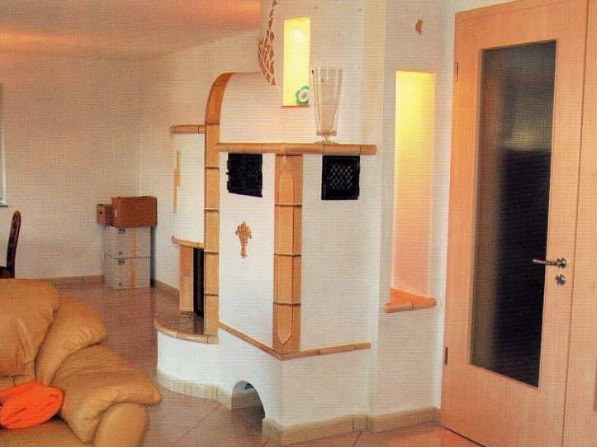In the solution, which line the walls of the furnace, it is possible to add various strengthening plaster additives and pigments. They make the coating more durable and long lasting, such that the lesion is most harmoniously fit into the interior.
To not have to watch cracks in newly plastered furnace in a solution need to add reinforcing material (e.g., straw or hemp). If the stove svejesobranna, plaster is applied to a metal grid with a mesh of 1/1 see It will keep the mortar from cracking under conditions of constant temperature difference.
There are several options for making heat resistant plaster. Most popular: clay with the addition of lime, lime with the addition of clay and cement, cement with additions of clay and lime. In any of these mixtures need to add any reinforcing materials: salt, asbestos, glass fiber, straw, hemp. If you decide to add salt, it will require 100-250 g per 1 bucket of solution. The finer the salt, the less it need.
Clay-sand mortar is prepared as follows: 1 part clay 2 parts sand. Cement-gliniany – 1 part cement, 2 parts sand, 1 part clay. Lime-gliniany – 1 part lime, 2 parts sand and 1 part clay. The number of reinforcing ingredient should be 1/10 of the volume of the mixture. Plaster would be much stronger if it is applied to clean burlap. But you should know. this stove can not overheat. Instead of burlap, you can take glass-fiber junctions with the cell 5-6 mm. This material is not afraid of no heat.
In the shops of building materials, you can find heat-resistant ready-mix for plastering the furnace. These compounds, in comparison with clay solutions, have several times more heat. They are perfectly able to withstand temperatures up to 200oC.
If you decide to use one of the above formulations, it is recommended to apply the first layer of solution to treat the wall of furnace heat resistant primer. It will close your pores of old plaster and improve its adhesion to the new one.
With the help of the primer can strengthen the wall of the oven the burlap or fiberglass junctions. This can be done: first, apply a first coat of heat resistant primer composition, after it dries attach to the wall reinforcing material and liberally greased it with the same agent. It will greatly simplify the process of plastering the stove.
Heat resistant plasters
To not have to watch cracks in newly plastered furnace in a solution need to add reinforcing material (e.g., straw or hemp). If the stove svejesobranna, plaster is applied to a metal grid with a mesh of 1/1 see It will keep the mortar from cracking under conditions of constant temperature difference.
There are several options for making heat resistant plaster. Most popular: clay with the addition of lime, lime with the addition of clay and cement, cement with additions of clay and lime. In any of these mixtures need to add any reinforcing materials: salt, asbestos, glass fiber, straw, hemp. If you decide to add salt, it will require 100-250 g per 1 bucket of solution. The finer the salt, the less it need.
Clay-sand mortar is prepared as follows: 1 part clay 2 parts sand. Cement-gliniany – 1 part cement, 2 parts sand, 1 part clay. Lime-gliniany – 1 part lime, 2 parts sand and 1 part clay. The number of reinforcing ingredient should be 1/10 of the volume of the mixture. Plaster would be much stronger if it is applied to clean burlap. But you should know. this stove can not overheat. Instead of burlap, you can take glass-fiber junctions with the cell 5-6 mm. This material is not afraid of no heat.
Modern means of increasing the heat resistance of the plaster to the furnace
In the shops of building materials, you can find heat-resistant ready-mix for plastering the furnace. These compounds, in comparison with clay solutions, have several times more heat. They are perfectly able to withstand temperatures up to 200oC.
If you decide to use one of the above formulations, it is recommended to apply the first layer of solution to treat the wall of furnace heat resistant primer. It will close your pores of old plaster and improve its adhesion to the new one.
With the help of the primer can strengthen the wall of the oven the burlap or fiberglass junctions. This can be done: first, apply a first coat of heat resistant primer composition, after it dries attach to the wall reinforcing material and liberally greased it with the same agent. It will greatly simplify the process of plastering the stove.
